Getting to Know Plants Class 6 Extra Questions Science Chapter 7
NCERT Extra Questions for Class 6 Science Chapter 7 Getting to Know Plants
Herbs, shrubs and trees
Question 1.
What are herbs?
Answer:
The small plants with soft/tender, green, short stem are called herbs. Herbs hardly attain height more than 1.5 metres. Their stems are not woody and can be bent. A herb may or may not have branches, e.g., tomato, mint, paddy, etc.
Question 2.
With the help of diagrams, tabulate the differences between a shrub and a tree, based on the properties of the stem.
Answer:
| Shrub | Tree |
| More branches arise from the base of stem. The stem is hard and thin. 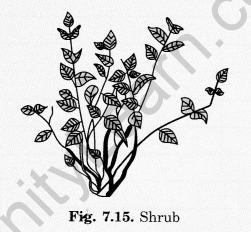 |
The branches arise from the stem. The stem is hard, thick and woody.  |
Question 3.
Look carefully at the plants shown in Fig. 7.17 and identify their type. Are they herbs, shrubs or trees? Are they similar in shape? Which category has the biggest plants and which has the smallest?
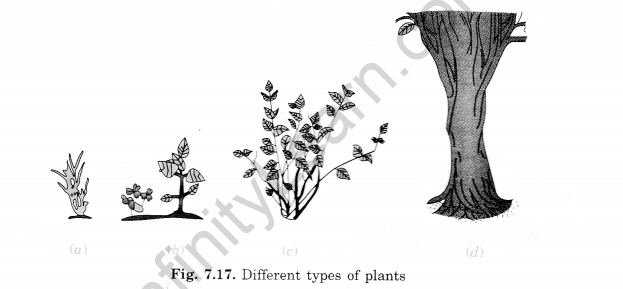
Answer:
Close look of these plants make it clear that these plants are not of the same type.
Plants and are small and have soft and thin stem. These are called herbs.
Plant has many branches arising from the base and its stem is thin but hard. It is a shrub.
Plant is tall. Its stem is thick and hard, it is a tree.
Question 4.
From the members of the various groups given below, find the odd one out.
- Coriander (dhania), mint (pudina), jamun, grass.
- Rose, mehndi, guava, morepankh.
Answer:
- Jamun (Jamun is a tree while others are herbs).
- Guava (Guava is a tree while others are shrubs).
Question 5.
You are shown three branches of a rose in Fig. 7.18 one will help you best to recognize the plant?
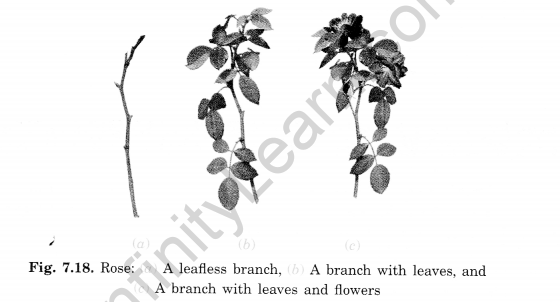
Answer:
(c) A branch with leaves and flowers
Question 6.
What are climbers and creepers? Give some examples.
Answer:
In some plants like grape vines, money plant, bean stalk, gourd plants, etc., the stem is so weak that it cannot hold it straight. They either stand up with some support or they just spread on the ground. In the first condition, the plants are called climbers and in second condition, they are called creepers or runners.
Question 7.
Pitcher plant has green leaves which can prepare food by photosynthesis then why does it eat insects?
Answer:
Pitcher plant eats insects to get nitrogenous compounds which it neither synthesizes nor can absorb from the soil.
Question 8.
What are weeds?
Answer:
The unwanted plants that grow in the field with the main crops or in their surroundings are called weeds.
Weeds are the plants which are not grown by the farmers, e.g., grass.
Stem
Question 1.
What is a stem?
Answer:
The part of the plant which generally grows above the ground level and bears leaves, flowers and fruits is called a stem.
Question 2.
Do you agree that stem is like a two way street?
Answer:
Yes. Stem carries the water absorbed by the roots to the leaves and also the food prepared by the leaves to the roots
Question 3.
Look carefully on the stem arising from various plants growing around you. Based on your observation, fill the following Table 7.1:
| S. No | Description of the stem | Name of the plant |
| 1. | Green and tender stem | |
| 2. | Hard, woody, thick brown stem | |
| 3. | Hard, woody, thin stem | |
| 4. | Branches arise from the base of the stem | |
| 5. | Branches arise from the upper part of the stem |
Answer:
| S. No | Description of the stem | Name of the plant |
| 1. | Green and tender stem | Pea |
| 2. | Hard, woody, thick brown stem | Mango |
| 3. | Hard, woody, thin stem | Ladyfinger |
| 4. | Branches arise from the base of the stem | Rose |
| 5. | Branches arise from the upper part of the stem | Rubber plant |
Question 4.
What are the modification of stem?
Answer:
Stem is modified to perform certain special functions:
- Storage of food
- Storage of water
- Provide support
- To make food
- Multiplication or reproduction.
Question 5.
What are nodes and internodes?
Answer:
Nodes: The point where the leaf arises on the stem. They are attached to the stem by a stalk.
Internodes: The portion of the stem between the two nodes.
Leaf
Question 1.
Define petiole and lamina.
Answer:
The part of leaf which is attached to the stem is called petiole and the broad green part of the leaf is called lamina.
Question 2.
Draw a labelled diagram of the external structure of a leaf.
Answer:
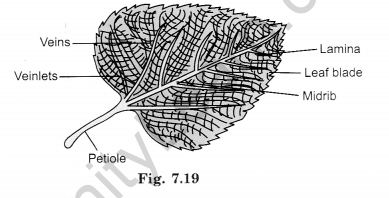
Question 3.
What are veins?
Answer:
There are some lines on the leaf called veins.
Question 4.
What is midrib?
Answer:
There is a thick vein in the middle of the leaf called midrib.
Question 5.
What do you mean by
- leaf venation
- reticulate venation, and
- parallel venation?
Answer:
- Leaf venation: The design made by veins in a leaf is called leaf venation.
- Reticulate venation: If the design is net-like on both sides of midrib, the venation is called reticulate venation.
- Parallel venation: In the leaves of grass, the veins are parallel to one another. This is called parallel venation.
Question 6.
Explain the main functions of leaf.
Answer:
There are following two main functions of leaf:
- Transpiration: The extra water comes out of the leaves through stomata in the form of vapour. This process is called transpiration.
- Photosynthesis: The process by which leaves prepare their food from water and carbon dioxide in the presence of sunlight and a green-coloured substance i.e., chlorophyll is called photosynthesis.
Question 7.
Why are leaves generally green?
Answer:
The green colour of leaves is because of the presence of chlorophyll.
Question 8.
What are the modifications seen in a pitcher plant?
Answer:
In a pitcher plant, the lamina is modified into a pitcher and apex into its lid.
Question 9.
Select leaves showing reticulate venation and those showing parallel venation from the list given below and write them in the tabular form:
Peepal, neem, grass, mustard, methi, dhania (coriander), rose, tulsi, mango, sugarcane, maize, mint, wheat, rice.
Answer:
| Reticulate Venation | Parallel Venation |
| Peepal | Grass |
| Xeem | Sugarcane |
| Mustard | Maize |
| Methi | Wheat |
| Dhania (coriander) Rose Tulsi Mango Mint |
Rice |
Activity 3.
Put a leaf under a white sheet of paper or a
sheet in your notebook. Hold it in place as shown in the figure. Hold your pencil tip sideways and rub it on the portion of the paper having the leaf below it. Did you get an impression wuth some lines in it? Are they similar to those on the leaf?
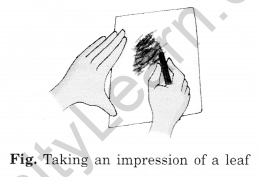
Yes, an impression with some lines in it is on the leaf. obtained. They are similar to those
Root
Question 1.
What are lateral roots?
Answer:
The smaller roots that grow on the main taproot are called lateral roots.
Question 2.
Why roots are modified?
Answer:
Certain plants have modified roots to perform specific functions:
- Storage roots, e.g., carrot, radish
- Supporting roots, e.g., banyan, rubber
- Climbing roots, e.g., money plant
- Parasitic roots, e.g., dodder
- Breathing roots, e.g., mangroves.
Question 3.
Explain the difference between taproots and fibrous roots with the help of diagrams.
Answer:
| Taproots | Fibrous Roots |
| There is only one main and long root from which small roots grow. | There is no main root. Many roots are grown together from the base of the stem in the form of bundle. |
| These roots go deep into the soil to more depth. | These roots do not go very deep. |
| These roots cannot be separated from soil easily. | These roots are easily separated from the soil. |
Found in the plants like weeds having reticulate venation in leaves. |
Found in the plants like grasses having parallel venation in leaves. |
Question 4.
What are the main functions of roots?
Answer:
Main functions of roots are:
- Roots absorb water and minerals from soil for the other parts of the plants.
- Roots hold the plant firmly to the soil.
- Some roots transform to store food, e.g., radish.
- Roots of leguminous plants contain symbiotic bacteria which add the fertility of soil by fixing atmospheric nitrogen into nitrates.
Question 5.
Identify the structure seen in Fig. 7.22 and write three sentences about it.

Answer:
This is a fibrous root. It has the following features:
- Roots are grown from the base of the stem.
- These roots do not go very deep into the soil.
- These roots are found in the plants having parallel venation in leaves, e.g., grasses.
Question 6.
How do you identify the root system of a plant without pulling it out of soil?
Answer:
By looking at the venation of the leaves, we can identify the root system of a plants. Plants with leaves having parallel venation have fibrous root and leaves having reticulate venation have taproot.
Question 7.
Uproot few different plants around you and study them. In Table 7.2 given below note the various parts seen in the different plants.
Table 7.2
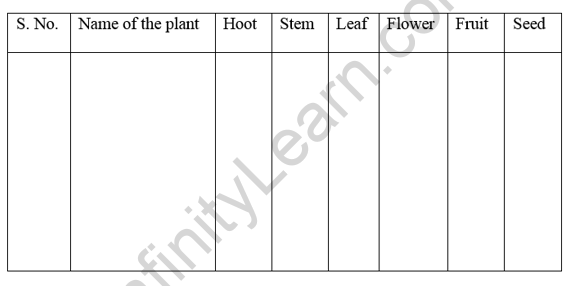
Answer:

Flower
Question 1.
What is a fruit? How does it differ from a seed?
Answer:
After fertilization, the ovary of the flower gets stimulated by the action of seed and forms the fruits, like mango, orange, etc. Embryo surrounded by a hard wall is called the seed.
Question 2.
Write the functions of sepals and petals.
Answer:
Functions of sepals: Sepals protect the inner parts of flower when it is a bud.
Function of petals: Petals attract the insects which are the agencies of pollination by colour and fragrance.
Question 3.
In what sequence does a plant bear?
Seed, Flower, Fruit.
Answer:
A plant bears first flowers, then seeds and in the last fruits.
Question 4.
Write the names of reproductive parts of a flower.
Answer:
The reproductive parts of a flower are:
- Stamens
- Pistil.
Question 5.
How will you cut an ovary in a proper way? Explain with the help of a sketch.
Answer:

Question 6.
Do all flowers have four separate whorls? Does any flower have more than four whorls? If so, write its name.
Answer:
No. Some flowers have some additional whorls than others. Sometimes some of these whorls may even be absent. For example:
- In Gudhal, an additional whorl of epicalyx is found.
- In unisexual flowers, either stamen or pistil is absent.
Question 7.
Do all flowers have the same parts and are they arranged in the same way?
Answer:
The flowers of different species of plants are different. The number of petals and sepals are different in different flowers. Some of the flowers have stamens and some flowers have only pistil, others have both. Sepals may be connected with petals in some cases; but in other cases, these may be separated. Thus the properties of flowers are different.
Question 8.
Name the male part of a flower. Draw its labelled diagram.
Answer:
Male part of a flower is known as stamen. It has two parts-filament and anther. Anther contains pollen grains.
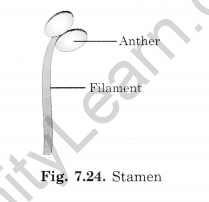
Question 9.
Draw a diagram of L.S. and T.S. of ovary to show ovules and locules.
Answer:
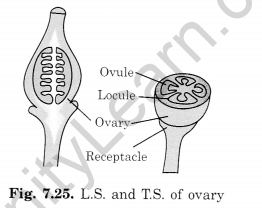
Question 10.
What do you mean by a complete and an incomplete flower?
Answer:
The flower with all whorls, i.e., sepals, petals, stamen and carpel in it is a complete flower.
If any one of these is absent in a flower, it is called an incomplete flower.
Objective Type Questions
Question 1.
Match the following items given in Column A with that in Column B:
| Column A | Column B |
| (a) Creeper | (i) Absorption of mineral and water. |
| (b) Herb | (ii)Manufacture food. |
| (c) Shrub | (iii)Transport food, water and mineral. |
| (d) Tree | (iv)Reproduction. |
| (e) Root | (v) Need support to stand up. |
| (f) Stem | (vi) Hard and thick stem. |
| (g) Leaf | (vii) Green and tender stem. |
| (h) Flower | (viii) Hard but thin stem. |
Answer:
| Column A | Column B |
| (a) Creeper | (v) Need support to stand up. |
| (b) Herb | (vii) Green and tender stem. |
| (c) Shrub | (viii) Hard but thin stem. |
| (d) Tree | (vi) Hard and thick stem. |
| (e) Root | (i) Absorption of mineral and water. |
| (h) Stem | (iii)Transport food, water and mineral. |
| (g) Leaf | (ii) Manufacture food. |
| (h) Flower | (iv) Reproduction. |
Question 2.
Fill in the blanks with appropriate words:
- Water Havels up the stem through …………. inside the stem.
- Thick vein in the centre of leaf is called ………….. .
- Design made by ……………. in a leaf is called venation.
- Leaves Bicchu (Meltles) give you …………. on touching.
- Leaves have ……………. shapes, sizes, edges, tips, etc.
- Water comes out of leaves in the form of vapour by a process called ………………. .
- Green leaves make food from ………………………, air and water by a process called photosynthesis.
- The fine hair like structures on the lateral roots are ………………… .
- Potatoes and jams are ………….. .
- Small fine particles present in the anther are called
- …………………… is the lower most part of a pistil.
- After maturation, ovary is converted into a
Answer:
- narrow tubes
- midrib
- veins
- rashes and itching
- different
- transpiration
- sunlight
- root hair
- stem
- pollen grains
- Ovary
- fruit
Question 3.
State whether the statements given below are True or False:
- Herbs are usually short and sometimes do not have branches.
- In shrubs, branches arise from the base of the stem.
- In trees, branches arise from the upper part of stem.
- Stem absorbs water and minerals from the soil.
- Roots hold the plant firmly in the soil.
- Leaves manufacture the food in presence of sunlight by the process of transpiration,
- Plants having leaves with reticulate venation have fibrous roots.
- All plants have colourful flowers.
- The parts of a flower are usually present in whorls.
- Pistil is female reproductive part of a flower.
Answer:
- True
- True
- True
- False
- True
- False
- False
- False
- True
- True
Question 4.
Choose the correct option in the following questions:
(i) Which is an example of a shrub?
(a) Spinach
(b) Mango tree
(c) Tomato plant
(d) Lemon
Answer:
(d) Spinach and tomato are herbs while mango is a tree. So lemon is a shrub.
(ii) Which of the following type of plants has thick, hard and woody stem?
(a) Tree
(b) Shrub
(c) Herb
(d) All of these
Answer:
(a) Herb has a soft stem while shrubs have thin stem.
(iii) Which is not a part of a leaf?
(a) Petiole
(b) Lamina
(c) Veins
(d) Nodes
Answer:
(d) Nodes are found on stem.
(iv) parallel venation is not found in
(a) sugarcane
(b) peepal
(c) maize
(d) wheat
Answer:
(b) In peepal, reticulate venation.
(v) Which one of the following is a function of leaves?
(a) Photosynthesis
(b) Transpiration
(c) Both (a) and (b)
(d) Support fruits
Answer:
(c) Leaves perform both functions.
(vi) Leaf venation and type of root is correctly paired in
(a) parallel venation, fibrous roots
(b) parallel venation, taproot
(c) no relation exists in leaf venation and type of roots
(d) reticulate venation, fibrous roots
Answer:
(a) Plants with parallel leaf venation have fibrous roots while plants with reticulate leaf venation have taproots.
(vii) Male reproductive part of flower is
(a) sepals
(b) petals
(c) stamens
(d) pistil
Answer:
(c) Stamen is male reproductive part.
(viii) Which is a correct set of parts of a pistil?
(a) Ovary, style and filament
(b) Ovary style and stigma
(c) Ovary, anther and filament
(d) Filament and anther
Answer:
(d) Filament and anther are the parts of stamen.
(ix) Which of the following has fibrous root?
(a) Peas
(b) Wheat
(c) Radish
(d) Neem
Answer:
(b) Wheat roots spread out in the soil.
(x) The process of loss of water by a plant through leaves is called
(a) evaporation
(b) condensation
(c) photosynthesis
(d) transpiration
Answer:
(d) The process of losing water by leaves is called transpiration.





